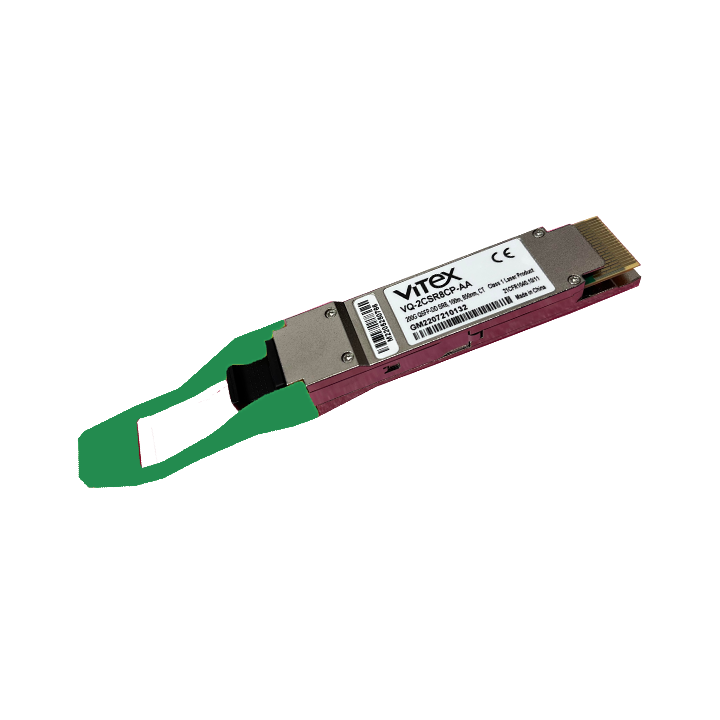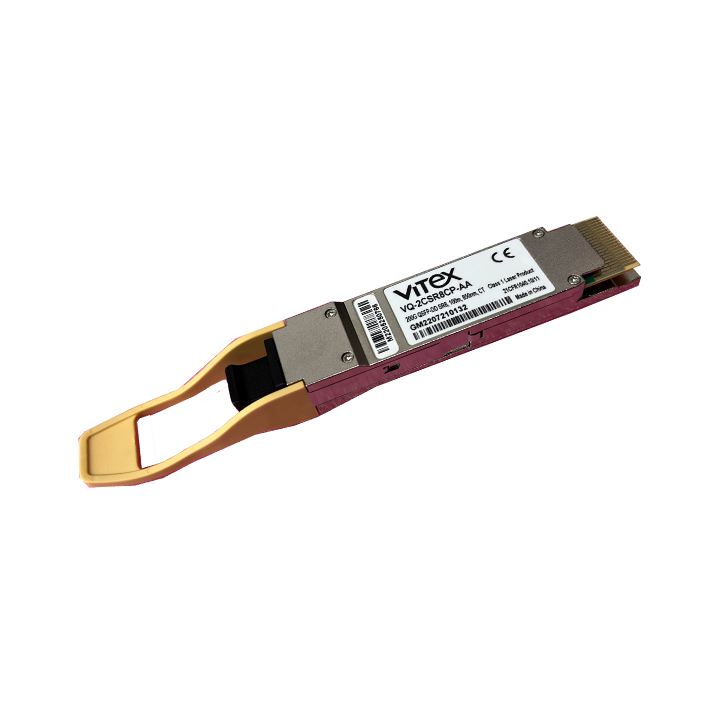QSFP56 and QSFP-DD are form factors that describe transceivers that meet specific engineering requirements. QSFP56, or quad small form factor 56, came out in 2017 and by its very nature represented a step forward in design over earlier QSFP modules. QSFP-DD (quad small form factor double-density), which was in development at the time, has since been refined and is now on the market. Its elegant intricate engineering architecture ultimately affords customers the option of future upgrades for their networks by accommodating higher speeds and bandwidths to process more data faster.
Both offer customers an array of options and come in multiple versions that support longer or shorter reaches.
Both were designed for high-performance computing and data centers. Both are carefully engineered, hot pluggable, plug-and-play, and compatible with many previous QSFP iterations. So, which one is right for you?
First, an overview of what they are engineered to do.
QSFP56
The QSFP56 module has four transmit and receive channels, each capable of 53.125 Gb/s operation which together yield an aggregate data rate of 200Gb/s. It utilizes 850nm, 1310nm, CWDM or LWDM wavelengths to transmit data. QSFP56 uses optical MPO or LC connectors for the optical interface and a 38-pin connector for the electrical interface. Unlike previous QSFP form factors, it leverages PAM4 digital modulation scheme.
The QSFP56 was engineered to support 200G Ethernet.

QSFP-DD
The QSFP-DD (quad small form factor pluggable double-density) optical transceiver is compliant with IEEE802.3bs and QSFP-DD MSA standards.
The double-density construction essentially multiplies lanes of electrical interface. While the QSFP28 transmits four lanes of 25Gb/s to achieve a total data rate of 100Gb/s, the 200G QSFP-28 DD (or the 200G QSFP-DD as it’s widely known) is designed with an eight-lane electrical interface and supports a 212.5Gb/s aggregate bit rate in total. The optical interface is either an MPO or duplex LC connector.

QSFP-DD is backwards compatible with most QSFP form factors including QSFP 56.
QSFP-DD electrical interfaces employ eight lanes that each operate on up to 25 Gbps NRZ modulation or 50 Gbps PAM4 modulation, providing solutions up to 200 Gbps or 400 Gbps respectively.
NRZ vs. PAM4
NRZ and PAM4 are two different types of digital modulation techniques. NRZ stands for non return to zero.
A modulation technique with two voltage levels representing logic 0 and logic 1, PAM4, or pulse-amplitude modulation, uses four voltage levels to represent four combinations of two bits logic-11, 10, 01, and 00.
A PAM4 signal can transmit twice as fast as the traditional NRZ signal.

Comparatively speaking, PAM4’s main advantage over NRZ is faster transmittal speed. Although not as fast, NRZ (at 200G) offers other desirable features, including lower power consumption, lower latency and easy deployment. 200G NRZ can achieve low-cost optical interconnection within data centers.
QSFP56 vs QSFP-DD: Comparative Advantages and Disadvantages
QSFP56
- was designed to support 200G applications and cannot accommodate an upgrade of 400G networks and beyond
- uses PAM4 modulation
- modules with PAM4 modulation require only the use of four lanes for 200G transmission
- is backwards compatible with QSFP-28 iterations but not with QSFP-DD
QSFP-DD
- runs in both 200G and 400G versions and allows incremental network upgrades
- typically runs on NRZ for 200G speeds
- QSFP-DD has eight lanes, which saves fiber cost and reduces link loss
- 200G QSFP-DD modules that run on NRZ modulation are not as fast but have other advantages, such as lower maintenance costs, less energy consumption, has less latency, better BER (Pre-FEC = E-8, Post-FEC = E-12) and are easy to deploy
- offers greater flexibility for network and systems engineers for upgrading networks; an upgrade option is a breakout application where higher speed QSFP-DD can be broken down to lower speed legacy form factors
- is backwards compatible with earlier iterations of QSFP modules, including QSFP56
- generally speaking, these transceivers are more expensive but rising market demand may drive prices down
Which One is Right for You?
Does your networking equipment accommodate upgrades to QSFP-DD? Not all switches, and routers, are configured to support QSFP-DD so stepping up to faster link speeds might be impossible or very costly. If you don’t have the right equipment, you incur the risk of greater signal-to-noise ratio and more interference in transmitting data. If that’s the case, QSFP56 might be a better choice.
If initial set-up cost is a concern, QSFP56 may be the better choice.
If cost is not an issue, you have the compatible hardware and want to have the capability of future upgrades and more complex configurations, QSFP-DD offers more possibilities and might be a better choice.
QSFP-DD transceivers can cost anywhere from 15% to 30% more than QSFP56 transceivers at comparable reaches. However, 200G QSFP-DD makes up for this initial cost by lower maintenance costs: it consumes less energy and power. Additionally, it achieves lower latency.
Regardless of which 200G transceiver you choose, both are good choices. Now’s the time to upgrade to 200G if you haven’t already done so.
Vitex engineers and technical support staff, with more than two decades of fiber optics engineering experience can customize solutions and provide guidance on the right products for your needs. Contact us at info@vitextech.com to discuss your requirements.
Related Products

